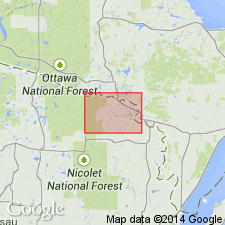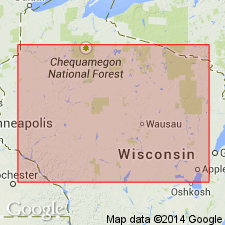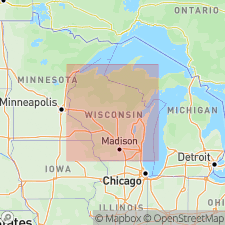
- Usage in publication:
-
- Florence Member
- Modifications:
-
- Original reference
- Dominant lithology:
-
- Till
- Silt
- Clay
- Sand
- AAPG geologic province:
-
- Wisconsin arch
Summary:
Pg. 3-4, 7 (fig. 10), 9 (table 2), 11-12. Florence Member of Kewaunee Formation. Till. Reddish-brown, unbedded, clayey unit of slightly gravelly clay, silty clay, and silty clay loam. Thickness 8 to 12 m. Overlies sand. In subsurface underlies Silver Cliff Member of Kewaunee Formation. Distinguished from similar units (notably underlying member W of Copper Falls Formation, lateral-equivalent member E of Kewaunee Formation, and overlying Silver Cliff), by grain size, absence of bedding, color, and presence of surface boulders. Age is Pleistocene (late Wisconsinan; middle Mountain advance).
Notable exposures in roadcuts behind late Mountain moraine, in SE/4 SE/4 sec. 5 and SW/4 SW/4 sec. 4, T. 38 N., R. 19 E.
Type section: in auger hole at the southwest corner of sec. 2, T. 38 N., R. 18 E., [approx. Lat. 45 deg. 47 min. 28 sec. N., Long. 88 deg. 13 min. 07 sec. W.], Iron Mountain SW 7.5-min quadrangle, Florence Co., northern WI.
Source: Publication.

- Usage in publication:
-
- Florence Member
- Modifications:
-
- Overview
- Dominant lithology:
-
- Till
- Silt
- Clay
- Sand
- AAPG geologic province:
-
- Wisconsin arch
Summary:
Pg. 57-58; see Clayton, Lee, 1986, Wisconsin Geol. Nat. Hist. Survey Inf. Circ., no. 51, 13 p. Florence Member of Kewaunee Formation. Reddish-brown unbedded till. Occurs at surface in type area; thickness 8 to 12 m near community of Homestead. Overlies sand of Horicon Formation. East of type area, in subsurface, underlies till or fluvial sediment of Silver Cliff Member of Kewaunee Formation. Interpreted as having been deposited during middle Mountain advance of Green Bay Lobe about 13,000 years ago (Pleistocene; late Wisconsinan).
Type section stated to be in auger hole at the southwest corner of sec. 2, T. 38 N., R. 18 E., [approx. Lat. 45 deg. 47 min. 28 sec. N., Long. 88 deg. 13 min. 07 sec. W.], Iron Mountain SW 7.5-min quadrangle, Florence Co., northern WI. At type, consists of slightly gravelly reddish brown silty clay loam, silty clay, and clay till, 0 to 10 m thick, and sand, 10 to 15 m thick.
[Additional locality information from USGS historical topographic map collection TopoView, accessed on June 9, 2018.]
Source: Publication.

- Usage in publication:
-
- Florence Member
- Modifications:
-
- Overview
- AAPG geologic province:
-
- Wisconsin arch
Summary:
[Not synopsized to date. Lithology, thickness, distinguishing characteristics, contacts, sections, areal extent, age, correlations discussed.]
Pg. 4 (fig. 2), 7 (fig. 3), 8, 138. Florence Member of Kewaunee Formation.
Source: NA
For more information, please contact Nancy Stamm, Geologic Names Committee Secretary.
Asterisk (*) indicates published by U.S. Geological Survey authors.
"No current usage" (†) implies that a name has been abandoned or has fallen into disuse. Former usage and, if known, replacement name given in parentheses ( ).
Slash (/) indicates name conflicts with nomenclatural guidelines (CSN, 1933; ACSN, 1961, 1970; NACSN, 1983, 2005, 2021). May be explained within brackets ([ ]).

